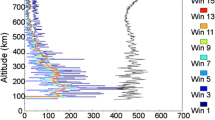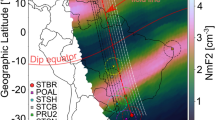Abstract
The FORMOSAT-3/COSMIC (F3/C) satellite probes the S4 scintillation index profile of GPS signals by using the radio occultation (RO) technique. In this study, for practical use on the Earth’s surface, a method is developed to convert and integrate the probed RO S4 index, so obtaining the scintillation on the ground. To estimate the worst case, the maximum value on each profile probed by F3/C, which is termed S4max, is isolated. The isolated data are further used to construct the global three-dimensional distributions of S4max for various local times, seasons, solar activities, and locations. The converted S4max for the first time estimates the global distribution of ionospheric scintillations in the GPS L1 band C/A code signal on the ground. The results show that the worst-case scintillations appear within the low-latitude region of ±30°N, peaking around ±20°N magnetic latitude; they begin at 1900 MLT, reach their maximum at 2100 MLT, and vanish by about 0200–0300 MLT. The most pronounced low-latitude scintillation occurs over the South American and African sectors.












Similar content being viewed by others
References
Aarons J, Klobuchar JA, Whitney HE, Austen J, Johnson AL, Rino CL (1983) Gigahertz scintillations associated with equatorial patches. Radio Sci 18(3):421–434
Aarons J, Mendillo M, Yantosca R (1997) GPS phase fluctuations in the equatorial region during sunspot minimum. Radio Sci 32(4):1535–1550
Abdu MA (2001) Outstanding problems in the equatorial ionosphere thermosphere electrodynamics relevant to spread-F. J Atmos Solar Terr Phys 63:869–884
Anthes RA, Ector D, Hunt DC, Kuo Y, Rocken C, Schreiner WS, Sokolovskiy SV, Syndergaard S, Wee T, Zeng Z, Bernhardt PA, Dymond KF, Chen Y, Liu H, Manning K, Randel WJ, Trenberth KE, Cucurull L, Healy SB, Ho S, McCormick C, Meehan TK, Thompson DC, Yen NL (2008) The COSMIC/FORMOSAT-3 mission: early results. Bull Am Met Soc 89:313–333
Arras C, Wickert J, Beyerle G, Heise S, Schmidt T, Jacobi C (2008) A global climatology of ionospheric irregularities derived from GPS radio occultation. Geophys Res Lett 35:L14809. doi:10.1029/2008GL034158
Azpilicueta F, Brunini C, Radicella SM (2006) Global ionospheric maps from GPS observations using modip latitude. Adv Space Res 38(11):2324–2331
Basu S, MacKenzie E, Basu S (1988) Ionospheric constraints on VHF = UHF communication links during solar maximum and minimum periods. Radio Sci 23:363
Brahmanandam PS, Uma G, Liu JY, Chu YH, Latha Devi NSMP, Kakinami Y (2012) Global S4 index variations observed using FORMOSAT-3/COSMIC GPS RO technique during a solar minimum year. J Geophys Res 117:A09322. doi:10.1029/2012JA017966
Burke WJ, Gentile LC, Huang CY, Valladares CE, Su SY (2004) Longitudinal variability of equatorial plasma bubbles observed by DMSP and ROCSAT-1. J Geophys Res 109:A12301. doi:10.1029/2004JA010583
Chu YH, Wang CY, Wu KH, Chen KT, Tzeng KJ, Su CL, Feng W, Plane JMC (2014) Morphology of sporadic E layer retrieved from COSMIC GPS radio occultation measurements: wind shear theory examination. J Geophys Res Space Phys 119:2117–2136. doi:10.1002/2013JA019437
Frihagen J, Troim J (1960) Scintillation of the 20 Mc/s signal from the earth satellite 1958δII. J Atmos Terr Phys 18:75–78
Hocke K, Pavelyev A, Yakovlev O, Barthes L, Jakowski N (1999) Radio occultation data analysis by radio holographic method. J Atmos Solar-Terr Phys 61:1169–1177
Hook JL, Owren L (1962) The vertical distribution of E-region irregularities deduced from scintillations of satellite radio signals. J Geophys Res 67(13):5353–5357
Huang CY, Burke WH, Machuzak JS, Gentile LC, Sultan PJ (2002) Equatorial plasma bubbles observed by DMSP satellites during a full solar cycle: toward a global climatology. J Geophys Res 107(A12):1434. doi:10.1029/2002JA009452
Kelley MC (2009) The earth’s ionosphere: plasma physics and electrodynamics, 2nd edn. Academic, San Diego
Mendillo M, Lin B, Aarons J (2000) The application of GPS observations to equatorial aeronomy. Radio Sci 35(3):885–904. doi:10.1029/1999RS002208
Olwendo O (2013) Studies in ionospheric TEC and equatorial scintillation over Kenyan region using GPS receivers, ionospheric monitoring: Africa Workshop, Hermanus, South Africa, 24–25 January 2013
Parthasarathy R, Reid GC (1959) Signal strength recordings of the satellite 1958δ2 (Sputnik III) at College Alaska. Proc IRE 47:78–79
Rastogi RG (1980) Seasonal variation of equatorial spread-F in the American and Indian zones. J Geophys Res 85(2):722–726
Rino C (2011) The theory of scintillation with applications in remote sensing. Wiley-IEEE Press, Hoboken
Sahai Y, Fagundes PR, Bittencourt JA (2000) Transequatorial F-region ionospheric plasma bubbles: solar cycle effects. J Atmos Sol-Terr Phys 62:1377–1383
Scherliess L, Fejer BG (1999) Radar and satellite global equatorial F region vertical drift model. J Geophys Res 104:6829–6842. doi:10.1029/1999JA900025
Sokolovskiy S, Schreiner W, Rocken C, Hunt D (2002) Detection of high-altitude ionospheric irregularities with GPS/MET. Geophys Res Lett 29:3. doi:10.1029/2001GL013398
Straus PR, Anderson PC, Danaher JE (2003) GPS occultation sensor observations of ionospheric scintillation. Geophys Res Lett 30(8):1436. doi:10.1029/2002GL016503
Su SY, Liu CH, Ho HH, Chao CK (2006) Distribution characteristics of topside ionospheric density irregularities: equatorial versus midlatitude region. J Geophys Res 111:A06305. doi:10.1029/2005JA011330
Sun YY, Liu JY, Chao CK, Chen CH (2015) Intensity of low-latitude nighttime F-region ionospheric density irregularities observed by ROCSAT and ground-based GPS receivers in solar maximum. J Atmos Solar-Terr Phys 123:92–101. doi:10.1016/j.jastp.2014.12.013
Thampi SV, Yamamoto M, Tsunoda RT, Otsuka Y, Tsugawa T, Uemoto J, Ishii M (2009) First observations of large-scale wave structure and equatorial spread-F using CERTO radio beacon on the C/NOFS satellite. Geophys Res Lett 36:L18111. doi:10.1029/2009GL039887
Thébault E, Finlay CC, Beggan CD, Alken P, Aubert J, Barrois O, Bertrand F, Bondar T, Boness A, Brocco L, Canet E, Chambodut A, Chulliat A, Coïsson P, Civet F, Du A, Fournier A, Fratter I, Gillet N, Hamilton B, Hamoudi M, Hulot G, Jager T, Korte M, Kuang W, Lalanne X, Langlais B, Jean- Léger M, Lesur V, Lowes FJ, Macmillan S, Mandea M, Manoj C, Maus S, Olsen N, Petrov V, Ridley V, Rother M, Sabaka TJ, Saturnino D, Schachtschneider R, Sirol O, Tangborn A, Thomson A, Tøffner-Clausen L, Vigneron P, Wardinski I, Zvereva T (2015) International geomagnetic reference field: the 12th generation. Earth Planets Space 67:79. doi:10.1186/s40623-015-0228-9
Uma G, Liu JY, Chen SP, Sun YY, Brahmanandam PS, Lin CH (2012) A comparison of the equatorial spread F derived by the International Reference Ionosphere and the S4 index observed by FORMOSAT-3/COSMIC during the solar minimum period of 2007–2009. Earth Planets Space 64:467–471
Watanabe S, Oya H (1986) Occurrence characteristics of low latitude ionosphere irregularities observed by impedance probe on board the Hinotori satellite. J Geophys Res 38:125–149
Wickert J et al (2001) Atmosphere sounding by GPS radio occultation: first results from CHAMP. Geophys Res Lett 28(17):3263–3266
Wu DL, Ao CO, Hajj GA et al (2005) Sporadic E morphology from GPS-CHAMP radio occultation. J Geophys Res 110:A01306. doi:10.1029/2004JA010701
Wu DL et al (2006) Remote sounding of atmospheric gravity waves with satellite limb and nadir techniques. Adv Space Res 37:2269–2277
Yeh WH, Huang CY, Hsiao TY, Chiu TC, Lin CH, Liou YA (2012) Amplitude morphology of GPS radio occultation data for sporadic-E layers. J Geophys Res 117:A11304. doi:10.1029/2012JA017875
Yeh WH, Liu JY, Huang CY, Chen SP (2014) Explanation of the sporadic-E layer formation by comparing FORMOSAT-3/COSMIC data with meteor and wind shear information. J Geophys Res Atmos 119:4568–4579. doi:10.1002/2013JD020798
Yunck T, Liu CH, Ware R (2000) A history of GPS sounding. Terr Atmos Oceanic Sci 11:1–20
Acknowledgments
The authors thank Prof. Chao-Han Liu at Academia Sinica for useful comments and suggestions. The F3/C S4max data are retrieved from the COSMIC Data Analysis and Archival Center (CDAAC) and the Taiwan Analysis Center for COSMIC (TACC). Taiwan. This study has been partially supported by the project, MOST 103-2628-M-008-001, granted by Ministry of Science and Technology (MOST) to National Central University. The authors thank the Editor in Chief for his suggestions for editorial improvements.
Author information
Authors and Affiliations
Corresponding author
Rights and permissions
About this article
Cite this article
Liu, J.Y., Chen, S.P., Yeh, W.H. et al. Worst-Case GPS Scintillations on the Ground Estimated from Radio Occultation Observations of FORMOSAT-3/COSMIC During 2007–2014. Surv Geophys 37, 791–809 (2016). https://doi.org/10.1007/s10712-015-9355-x
Received:
Accepted:
Published:
Issue Date:
DOI: https://doi.org/10.1007/s10712-015-9355-x




